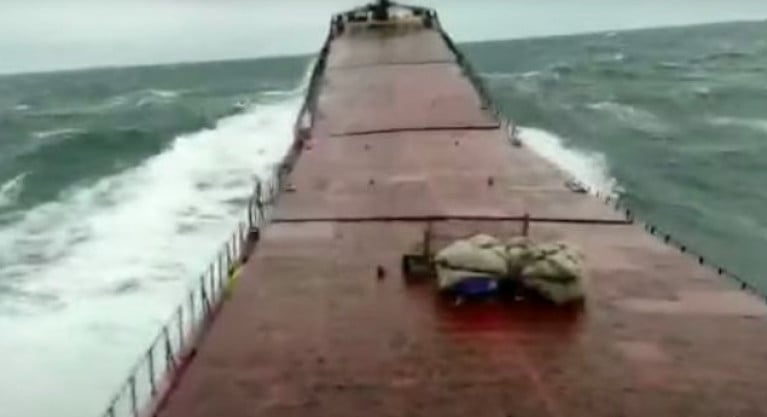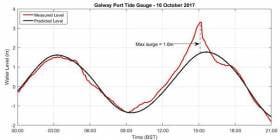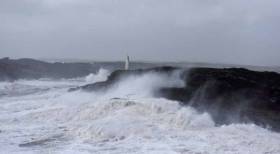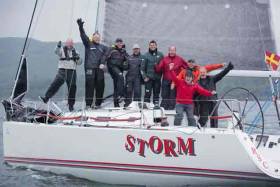Displaying items by tag: Storm
Irish Scientists Celebrated in New List of Storm Names for 2023-2024
Leading Irish/Northern Irish scientists feature in the new list of storm names released by Met Éireann and British and Dutch counterparts.
Among them is “Lilian”, after Lilian Bland, an Anglo-Irish journalist and the first woman in Ireland to build and fly an aircraft. She is also possibly the world’s first woman to build her own aeroplane, the Bland Mayfly.
Also selected is “Kathleen”, after Kathleen ‘Kay’ McNulty Mauchly Antonelli, one of the mothers of computer programming, and Kathleen Lonsdale, an Irish crystallographic, who demonstrated the crystal structure of benzene.
Storm “Jocelyn” is named after Jocelyn Bell Burnell, the Northern Ireland astrophysicist who discovered the first pulsating radio stars, or pulsars, in 1967.
Other Irish scientists also included in the storm names list are Agnes Mary Clerke, Irish astronomer and science writer; Fergus O'Rourke, a scientist and entomologist who provided an authoritative description of Irish ants; Nicholas Callan, the physicist who invented the induction coil that was used in early telegraphy; and Vincent Barry, the organic chemist who led the team which developed the anti-leprosy drug clofazimine.
Met Éireann, the British Met Office and KNMI of the Netherlands released the list for the 2023/2024 season on the eve of its start on September 1st.
Each of the three meteorological services contributed seven names to this season’s list. The full alphabet is not used as the letters Q, U, X, Y, and Z are not included, in line with the US National Hurricane Centre naming convention.
Storms are named when they could cause “medium” or “high’ impacts” in one of the three partner countries, the three services explain.
“This enables consistent, authoritative messaging to support the public to prepare for and stay safe during potentially severe weather events,” they state.
Eoin Sherlock, Head of Forecasting Division in Met Éireann, said that storm naming is “an important asset in our warnings arsenal and makes severe weather communications clearer and more effective”.
“We are delighted to celebrate science and scientists in this year’s names. As part of our process we asked the public to choose the name for letter “A”, resulting in Agnes, after Irish astronomer and science writer Agnes Mary Clerke. Our warmest thanks to all who voted and to those who suggested other names that we will keep in mind for future seasons,”he said.
“As we move in to storm season, we advise people to prepare now for possible severe weather events. We echo public safety advice to “Be Winter Ready”. You can find the latest forecasts and warnings in met.ie and Met Éireann’s app,” Sherlock said.
Prof Jocelyn Bell Burnell expressed delight at being selected in “this distinguished list celebrating science and hope that if a potential “Storm Jocelyn” happens, it may be a useful stirring-up rather than a destructive event!”
“ Science advancements increase our knowledge and understanding of the world around us, and I think this is wonderful example of science-based services communications,” Bell Burnell said.
Met Éireann and the Britih Met Office have been working together on the naming programme since 2015, and were joined by the Netherlands’ KMNI in 2019.
British Met Office Head of Situational Awareness Will Lang said, “this is the ninth year of us naming storms, and we do it because it works”.
“Naming storms helps to ease communication of severe weather and provides clarity when people could be impacted by the weather. This year, it’s great to be able to recognise the collaborative efforts of some of our partners across the UK with the inclusion of names from some UK partner organisations. Working across different agencies allows us to help as many people as possible be prepared for severe weather,” Lang said.
KNMI Senior Forecaster and Team Manager Jos Diepeveen said that “through recognisable names, we hope to reach as many people as possible with our warning before the weather strikes”.
“For this year’s KNMI input, we have asked visitors during our open day last October for suggestions. Visitor Babet filled in her own name, stating ‘Because I was born during a storm’,” Diepeveen said.
Other national meteorological service groups in north America and Europe also name storms, and when any national service names a weather system, all others keep that name.
This includes ex-hurricanes named by the US National Hurricane Centre such as Hurricane Charlie (August 25th, 1986) and Ophelia ( October 16th, 2017), which had major impacts in Ireland when they crossed the Atlantic, the three services state.
The full 2023/24 list is:
- Agnes
- Babet
- Ciarán
- Debi
- Elin
- Fergus
- Gerrit
- Henk
- Isha
- Jocelyn
- Kathleen
- Lilian
- Minnie
- Nicholas
- Olga
- Piet
- Regina
- Stuart
- Tamiko
- Vincent
- Walid
CraftInsure Issue Top Tips to Help Avoid Storm Damage
‘Antoni’ and ‘Betty’ provided a sharp reminder that we are not immune to severe storm conditions even in mid-summer.
Craftinsure is helping a number of customers who have fallen victim to recent bad weather.
Claims have included a yacht capsizing on moorings, a Drascombe breaking adrift (sadly completely destroyed), smaller motorboats swamping and other boats suffering less serious damage from violent motion against piers and jetties even though well secured and heavily fendered.
Craft Insure has also received reports of dinghies being blown over despite being tied down and one yacht in a cradle ashore.
As we head towards autumn, here are our top tips to help avoid storm damage:
- If bad weather is forecast, try to get your boat ashore or to a more sheltered location if feasible; smaller boats, especially if fitted with heavy outboards, are particularly vulnerable to swamping and capsizing on moorings.
- Double up on mooring lines and springs.
- Check your boat regularly, adjusting lines and fenders as appropriate.
- Dinghies should be securely tied down to the ground (and not the trailer).
- Moorings should be checked at least annually; replace any suspect components and double up on strops.
- Yachts ashore should have boom covers and spray dodgers removed to reduce windage. Unstep masts at the end of the season.
- Make sure furling headsails are securely tied to prevent being blown out.
Storm Arwen: RNLI Urges Public to Take Extra Care as Strong Winds & Large Seas Forecast
The RNLI is urging people to take extra care over the coming days as strong winds and large seas are expected during Storm Arwen which is forecasted to make its approach from the early hours of tomorrow (Friday morning).
With high winds and large seas anticipated on Friday and Saturday, the RNLI is urging people to exercise extreme caution if visiting the shoreline, especially along exposed cliffs, seafronts and piers. The charity is asking people not to take unnecessary risks – breaking waves can easily sweep you off your feet and out to sea.
Kevin Rahill, RNLI Water Safety Lead said: ‘Storm Arwen could make visiting our coasts treacherous and bring very dangerous sea conditions. The RNLI would advise people to stay out of the water during these stormy conditions. Swimming in large waves and rough seas can be dangerous where currents can drag someone away from the shore and in addition to that, the rough weather can make it difficult to spot someone in the water should they get into difficulty. Large waves can also make exiting the water difficult and increase the risk of injury’
‘While stormy conditions may be tempting to watch, it is important to remember the sea is very dangerous and unpredictable and big waves can easily knock you off your feet. We would urge people to stay well back from the edge to avoid being swept in by large waves crashing over rocks and piers. As well as the risk of being swept into the sea, large waves can often undermine cliff edges and make them unstable. If you think someone is in danger, please dial 999 or 112 and ask for the Coast Guard.’
Four Irish Names on New International Storm List
Barra, Méabh, Pól and Seán are among the names that have made it on the latest international storm list for 2021 to 2022.
Diarmuid was put to a vote along with Duncan, Dudley and Dafydd.
However, Dudley was the winner – perhaps influenced by the “magic” of the fictional character in JK Rowling’s Harry Potter series of books, three weather services have said.
The list for the 2021-2022 storm season was drawn up by Met Éireann, the British Met Office and the Dutch weather service KNMI.
Met Éireann and the British Met Office have been working together since 2014 on the “storm names partnership” and were joined by KMNI in 2019.
Similar to previous years, each weather service has contributed names reflective of their nation and culture, mainly suggested by members of the public.
The new list begins with Arwen, and continues with Barra or Finbar, Corrie and Dudley.
Also selected are Eunice, Franklin, Gladys, Herman, Imani, Jack, Kim, Logan, Méabh, Nasim, Olwen, Pól, Ruby, Séan, Tineke, Vergil and Willemien.
“Last winter was relatively quiet with only one storm named by Met Éireann - Storm Aiden at Halloween,” Met Éireann’s head of forecasting Evelyn Cusack noted.
“Once again Met Éireann will continue to work with our national weather service colleagues in the UK and Netherlands by continuing to provide a clear and consistent message to the public, and encouraging people to take action to prevent harm to themselves or to their properties at times of severe weather,” she said.
“Also this month we are delighted to see the launch of our new audio weather forecasts, where people can listen to the latest forecast delivered by our team of Met Éireann forecasters,” Cusack added.
“We’re all aware of some of the severe weather that has been witnessed across Europe and globally in recent months,”Will Lang, Met Office head of the national severe weather warning service said,
“ We work to use any tool at our disposal to ensure the public is informed of potential risks, and naming storms is just one way we do that,”Lang explained.
“Storms are not confined to national borders - it makes a lot of sense to given common names to such extreme weather events,” Gerard van der Steenhoven, KNMI director general, said.
Cargo Ship ‘Snaps in Half’ During Storm (Video)
A ship ‘snapped in half’ and sank off Turkey’s Black Sea coast while en route to Bulgaria.
Now, as Marine Industry News reports, a shocking video has been shared showing the crew making an emergency mayday call as the bow breaks.
Reports vary – some say that up to four crew members died in the incident. Rescue workers reportedly saved at least six people and retrieved the bodies of two others.
The Russian state agency overseeing sea and river fleets says the vessel belonged to the Ukrainian company Arvin Shipping Ltd.
According to Deha 24, Arvin is a river-sea cargo vessel type, vulnerable to strong storms at sea, because its structural strength isn’t sufficient enough to be fully seaworthy – it was too long and narrow. Arvin couldn’t stand against strong wind and waves and either broke in two, or was overwhelmed, while being anchored at Bartin anchorage in an attempt to shelter from a storm.
Galway Docks Hit by Localised Storm Surge
There were severe gales around much of Ireland on Wednesday night, but at Galway Docks, in particular, the localised effects of a storm surge on extreme high water – with southwest winds of more than 70 knots - caused the Aran ferry to break some of its mooring lines at its berth outside the dock gate at the Fishermen’s Layby, with the ship finally coming to rest across the RNLI launching berth, effectively closing off the rescue services until the vessel could be re-floated this morning.
As Afloat reported earlier, the situation prompted Galway’s Harbourmaster to hit out at the lack of a storm warning.
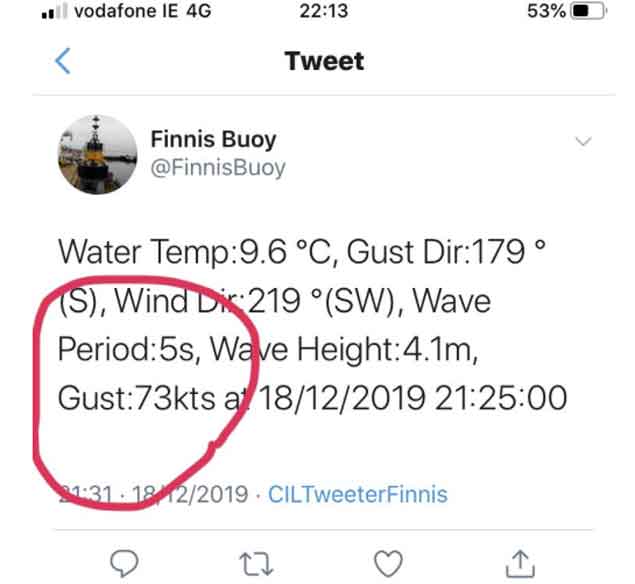 Precision measurement of a storm – in Galway Bay last night with south to southwest winds hitting 73 knots, the steep short waves on a period of 5 seconds were peaking at 4.1 metres.
Precision measurement of a storm – in Galway Bay last night with south to southwest winds hitting 73 knots, the steep short waves on a period of 5 seconds were peaking at 4.1 metres.
Conditions were such that the lock-gates themselves could not be closed until two hours after high water, while the ferry – having been freed today (Thursday) with the use of two mechanical diggers required to demolish part of a wall – has sustained quite substantial damage.
Experienced local sailors are saying that the night’s damage proved yet again that serious money needs to be spent, both to improve shelter and access to the entrance to Galway Docks, and provide better berthing generally for the most important port in Connacht.
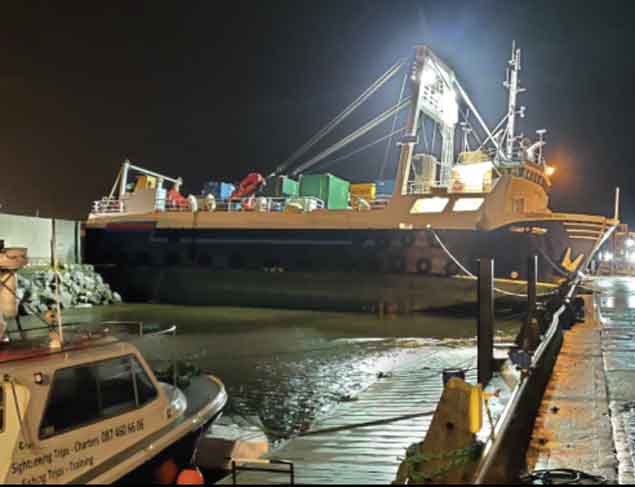 The Aran Islands ferry broke adrift from its alongside berth just outside the dock gates, and ended up aground across the entrance to the RNLI launching berth, with considerable damage sustained by the time the ship was refloated today (Thursday). Photo: Courtesy Pierce Purcell
The Aran Islands ferry broke adrift from its alongside berth just outside the dock gates, and ended up aground across the entrance to the RNLI launching berth, with considerable damage sustained by the time the ship was refloated today (Thursday). Photo: Courtesy Pierce Purcell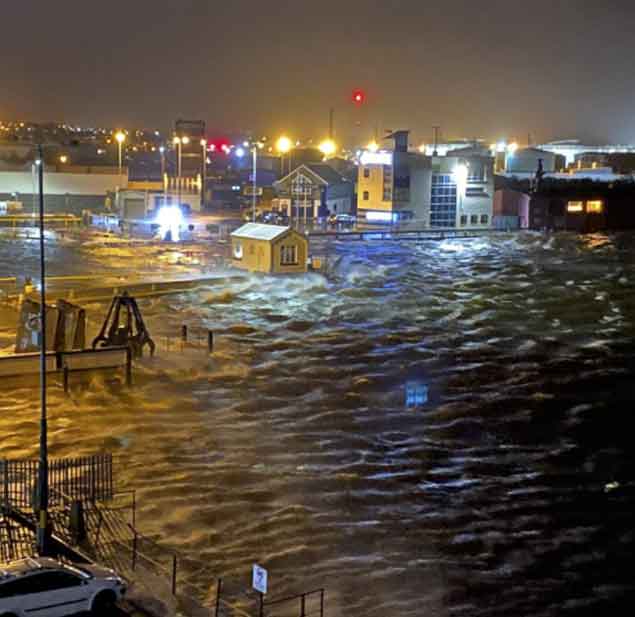 Collateral damage……some of the area immediately around the docks was flooded. Photo: Courtesy Pierce Purcell
Collateral damage……some of the area immediately around the docks was flooded. Photo: Courtesy Pierce Purcell
Pat Kelly and his family and friends from Rush in the heart of Fingal certainly enjoy their sailing. But they work hard to ensure that their all-conquering J/109 Storm is in peak condition as the new programme starts, and they’ve got the 2018 season off to a flying start with a victorious tour of Scotland. Storm won overall at the Kip Regatta, and then retained the title of Overall Champions in the annual Scottish Series on Loch Fyne, a formidable double.
Ophelia: Crunching The Numbers On Galway’s ‘Unusual’ Storm Surge
#Ophelia - With most of Ireland battening down the hatches for the second time in a week in preparation for Storm Brian’s arrival, the Marine Institute in Galway says it continues to gather and analyse data from Storm Ophelia.
Despite Galway escaping much of the worst of the wind damage associated with Monday’s storm, a short-lived but notable surge of 1.6m just after 3pm resulted in flooding in a number of well-known locations across the city.
Storm surges occur when strong winds ‘push’ water up against a coastline and low atmospheric pressure associated with a weather system such as Ophelia raise the sea surface further.
Surges in the sea level, measured by the Irish National Tide Gauge Network, were seen around the Irish coast. But the timing of the storm passing over Galway with its associated peak in wind speed coincided with the approach of high tide, resulting in flooding at the Docks, Spanish Arch and Salthill Promenade.
What was unusual was how quickly the surge dissipated, the Marine Institute adds, noting that the predicted high tide occurred just 30 minutes after the peak surge, but the surge itself had dropped by 1.25m to only 35cm in that time.
The unusual nature of the surge can most likely be explained by a rapid change in direction and speed of the wind field in Galway Bay but further investigation is required to understand the event fully.
As previously reported on Afloat.ie, the Irish Marine Weather Buoy Network recorded a record sixty-foot wave off the South East Coast on Monday afternoon before the M5 buoy broke from its moorings.
Among those feeling the effects in the water was Dingle's resident dolphin Fungie, who was found to have a number of serious cuts on his body during the week – though as Buzz.ie reports, he's expected to make a full recovery.
Elsewhere, Michael Viney writes in The Irish Times how Storm Ophelia's advance on Ireland stumped a key resource for Ireland's big wave surfers – one of whom has defended his decision to ride the storm-powered swell off Killiney in Co Dublin to TheJournal.ie.
Storm Ophelia & Ireland: It has Renewed our Sense of Ourselves
A former hyper-active hurricane, only very recently re-classed as a severe tropical storm, hits southwest Ireland at dawn from south of southwest on a mid-October Monday morning writes W M Nixon. It spends the entire day tracking destructively across country, until it finally departs from our island to the northeast.
It sounds like the demented scenario for a majestic blockbuster movie. Such a mega-film would use special effects to get the full impact of the various disasters which arise as this Enemy of the People – personalized by being called Storm Ophelia - does her worst to provide extreme conditions in which people (inevitably a cast of thousands) will dramatically respond in their many and various ways, some truly selfless, others anything but.
It would definitely be a big budget production. We can know that for certain. For on this post-storm morning, with weather of surreal and gentle beauty after Ophelia has gone on her way, the cost of clearing, repair and re-build will surely run to many millions when all is finally put right, which will certainly be months rather than days or weeks.
Yet how have we as a people and an island nation emerged from it? The feeling is encouraging. There seems to be a heightened sense of ourselves in a fairly benign light, an awareness that when push comes to shove, our infrastructure and emergency services can rise to the challenge, provided all the people of Ireland quietly help them by not making unreasonable demands for their assistance.
For sure, three deaths is three deaths too many, particularly as in two cases it involved the victims helping others. But in the wholesale felling of trees, the destruction of property with the particularly horrible risk of flying debris, and in the hour after hour of the flooding of rivers and the battering of coasts and harbour with boats at risk everywhere, people took expert advice and generally kept themselves as much as possible out of harm’s way.
And this of course is where we realize how much things have moved on from our previous experiences of extreme weather conditions. Meteorology has advanced so much with short-term forecasts achieving such precision that those who had business out of the house which simply had to be dealt with knew to within half an hour when they absolutely had to be back safely indoors.
So Met Eireann now has even more respect as a National Treasure. As for the comforting presence of a sensible stream of practical advice from the National Emergency Co-ordination Group (NECG), that was exactly what was needed to encourage everyone to be sensible and avoid unnecessary risks, while its Chairman Sean Hogan has become the nation’s poster boy for “Keeping Calm in the Midst of Storms”.
With the main drama being played outdoors, inevitably there were those who had to take on risky repair and remedial work in exposed places at the scene of damage, and the rest of us were lost in admiration for the Electricity Service teams. Most of us know little enough about how electricity works in the first place, yet these guys not only has to know it in life and death situations, but they had to be skilled foresters and tree surgeons as well as they went about their highly dangerous tasks.
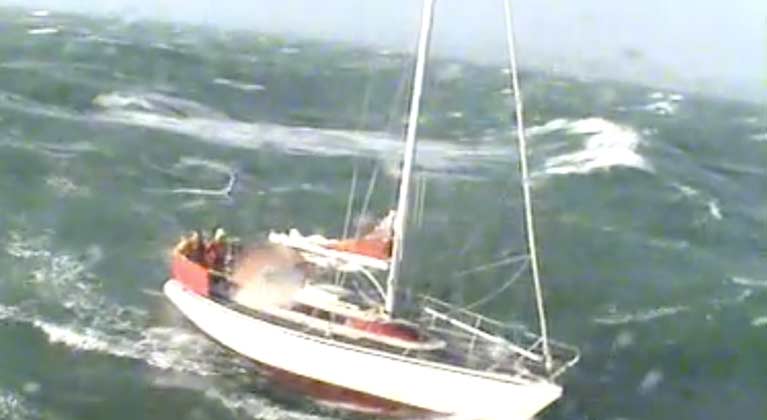 Conditions were extremely challenging with force nine winds with a six metre sea swell when Rosslare RNLI went to rescue this yacht in the Irish Sea
Conditions were extremely challenging with force nine winds with a six metre sea swell when Rosslare RNLI went to rescue this yacht in the Irish Sea
Finally, there’s the episode of that rescue by the Rosslare Lifeboat of a yacht in distress at the height of the storm. Some day we’ll learn just how the yacht was there at all, for heaven knows Ophelia had been well signaled for days in advance. But oddly enough, that’s not too important this morning, What is important is that Cox’n Eamonn O’Rourke and his crew – all volunteers – were assembled within minutes, they carried out a text-book rescue with clinical precision, and the country could return to keeping itself safe for the day, as we’d been advised to.
Because although there’d been some grumblings that the warnings beforehand were surely tending towards exaggeration, they weren’t. The three tragic deaths were three deaths too many, and infinitely sad. But yesterday could have been a continuing litany of personal tragedies if people had deluded themselves that they could have got away with cheating such a prodigious force of nature.
So we emerge from our encounter with Storm Ophelia with a heightened sense of ourselves as a mature nation. Ireland is unique – a medium-sized island on the leeward side of one of the roughest oceans in the world. Our population is such that we have to stretch resources to provide the services and expertise which countries with larger populations can take in their stride.
Yet when Storm Ophelia tested those services, Ireland was not found wanting. And we Irish conducted ourselves like sensible adults who will accept a certain amount of discipline when it is presented to us in a competent and reasonable manner.
On this, the day after the storm, we can feel quietly proud of being Irish.
Anyone who has ever raced against the J/109 Storm, campaigned by Pat Kelly and his close-knit family from Rush Sailing Club, quickly realises that they are up against something special in sailing. This is evident both with the Storm team themselves, and with the rising spirit of the small-sized but big-hearted club they call home, a club which has already logged formidable success at junior and senior levels, inshore and offshore, during the first weeks of the 2017 season.
Mooring facilities at the Rush club’s tide-riven anchorage on Rogerstown Estuary in the heart of Fingal are so confined that Storm is actually based at Howth Marina. But while she’s very welcome and popular there, no-one has any doubt that she’s the boat from Rush. It is a pleasure to watch her being raced by the Kelly’s remarkable family unit, augmented by their relatives and friends. We saw the essence of their approach on Monday in the final and vital two races of the Silvers Scottish Series 2017 at Tarbert. Storm handled both of these contests with clinical precision to take the overall class lead in convincing style from seven other possible winners. The Kelly Family of Rush are worthy Afloat.ie “Sailors of the Month” for May 2017.


























